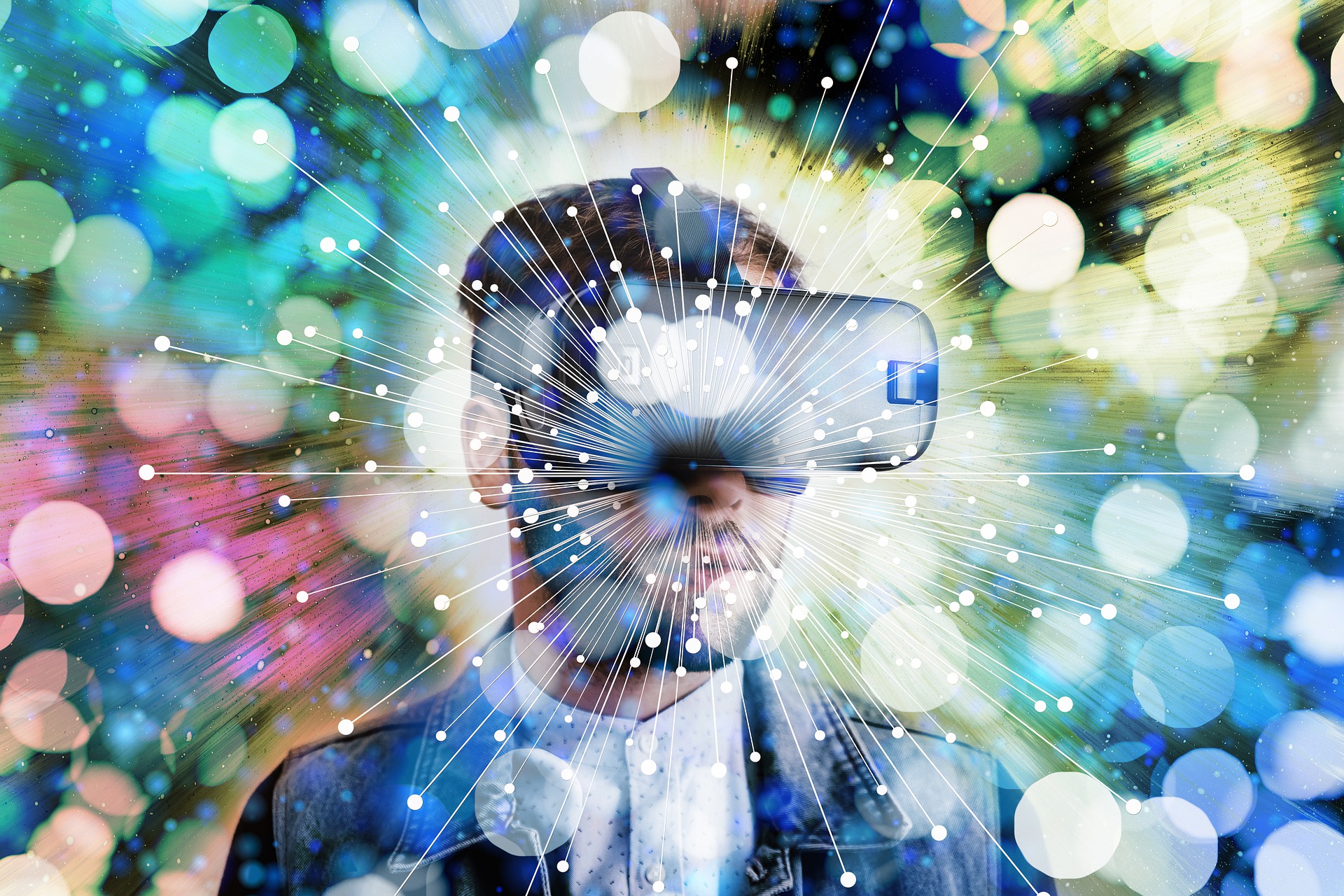
Augmented Reality (AR) is the next big thing in new tech and there's a reason for it: new developments are happening at rapid fire pace that is creating an amazing experience.
AR adds layers of virtual objects to the real environment. In contrast to Virtual Reality (VR), AR is an interactive experience of a real world environment where the objects in the real world are enhanced by computer generated perceptual information.
AR combines the real and virtual world, a real time interaction and accurate 3D registration of real and virtual objects across multiple senses.
The overlaid sensory info can be destructive where the natural environment can be masked to show virtual items, constructive or additive to the natural environment.
VR on the other hand replaces reality completely with a virtual reality.
The 1st AR technology was developed in 1968 in Harvard when computer scientist Ivan Sutherland created an AR head mounted system but it didn’t really take off until 2016 when Pokemon Go launched.
In addition to video games that allow you to fight epic battles in your living room, with systems like Lenovo Mirage (smartphone powered AR) there are applications for space exploration as well.
Here's Seismic Games debut teaser trailer for Blade Runner: Revelations, on the Lenovo Mirage Solo Google Daydream headset:
Nasa has stated they plan on using AR to keep track of astronaut’s health while they are in space.
Using a customized, 3D virtual reality (VR) simulation that animated the speed and direction of 4 million stars in the local Milky Way neighborhood, astronomer Marc Kuchner & researcher Susan Higashio obtained a new perspective on the stars’ motions, improving our understanding of star groupings.
Nasa scientists, using VR animated star clusters, found stars that may have been classified into the wrong groups as well as star groups that could belong to larger groupings.
Google is using AR to translate street signs and books in real time from one language to the user’s native language:
Medical training, education, manufacturing, military, are all industries that are planning on using AR for virtual floating touch screen objects that hang in mid air.
Some really cool camera-based AR apps out right now include on the simplest level, iPhone’s free measure app that lets you measure the size of someone’s height in real time or tables length and width.
Ikea created an app called Ikea Place that lets you virtually place true to scale 3D models of Ikea furniture in your living room.
You’ll select an item from their digital catalogue, then using your smartphone camera you take a picture of your place. Then you can put the furniture anywhere in your house to see how it would look in real life.
The fashion industry isn’t getting left out of the loop for AR either. Many clothing brands let you try on clothes virtually so you can see what you’d look like in new threads without physically having to be there.
One of the the neatest AR apps out there that’s free is called Jig Space. This app lets you explore 3D objects in space, history, inside the planet Earth, how-to, machines and more.
One of the biggest issues with AR is that data has to be real time rendered right as an end user makes a decision without images and info lagging. 5G phones may help with this.
Real time content and AR content sometimes aren’t able to respond to each other fast enough to create a smooth experience.
MR or mixed reality hopes to fix this issue by using occlusion to remove the boundaries between real and virtual interactions.
MR merges real and virtual worlds together to create new environments and visualizations. Where physical and digital items coexist and interact with each other in real time.
MR doesn’t take place in exclusively the physical or virtual world, but is a hybrid reality where both come together.
While MR is similar to Augmented Reality one of the main distinctions between the two is that Mixed Reality allows a virtual overlay of graphics to interact with the real world. If you're dealing with Zoom fatigue you'll have a lot more options now,
Last year in February (2019) Microsoft came out with a new product called Hololens 2. These are Mixed Reality Smart Glasses. Their product demo was pretty impressive, using an application created with the unreal engine.
A few months later, the Hololens 2 Emulator was released to developers to allow them to create applications for the Hololens 2.
The Hololens 2 features include:
A diagonal field of view of 52 degrees, a resolution of 47 pixels per degree, accelerated work loads such as eye tracking, spacial audio, fully articulated hand tracking, semantic labeling and more.
The price tag is a bit heft at $3500 dollars.
AR, VR and MR is at the forefront of new business ventures predicted to create windfalls for both investors and creators, especially given current occupation limits, social distancing and stay at home orders which are intense in countries like Australia.
With everyone at home so often these days, Augmented Reality shows promise of sky rocketing in demand and sales as does VR and MR.
AR, Virtual Reality (VR), and MR are under the umbrella of XR or Extended Reality.
We’ve gone from hunters and gatherers to 3D printing hamburger patties grown from stem cells without harming animals or cutting down rain forests for cattle grazing lands.
While much of this new tech that can solve resource deficits has yet to be deployed at a level prevalent enough to have a global impact - we have the tools now to solve major issues like world hunger and starvation at a lower cost.
I hope this is something that becomes sponsored as a world-wide initiative to help end the nutrition issues in developing countries, food deserts in the United States of America and problematic issues for starving military families that are denied benefits.
But that’s more on the 3D printing and stem cell grown food topic, going back to AR, VR and MR, you’d think there would be once device that harnesses all three in XR.
And there is.
May 2020 Qualcomm who makes the chip for the Oculus Quest VR headset announced they are colloborating with 15 world operators to create XR viewers.
These operators are planning on making XR part of their 5G offerings for both businesses and consumers, debuting next year in 2021.
These XR viewers will be a pair of light weight glasses with 8K 360 degree video capabilities.
They’ll connect to a smartphone powered by Qualcomm’s Snapdragon 855 or 865 mobile platform. These will be tethered via UBC cable to the 5G smartphones for an immersive XR experience with high bandwidth and low latency.
This will allow everyday experiences like doing planks for your morning workouts can become Augmented Reality experiences right before your eyes.
In the business world, these XR glasses can facilitate workplace meetings with holographic telepresence using virtual collaboration platforms.
It’s predicted that XR Viewers will become wireless and 5G tethered glasses will become available.
NVIDIA is another tech company vying for a place in XR tech wave maker history. Nvidia is known for designing GPUs. Their Cloud XR is their foundation platform for streaming Virtual Reality, Augmented Reality & Mixed Reality content from any open VR or XR application on a remote server.
Another contender is Nreal light glasses, which look pretty badass and are priced at around $586).
Nreal previously shipped a $1,199 developer kit that included a controller and a dedicated mini-computer.
The Nreal Light is a light sunglasses-style headset that tethers to a separate computing device — in this case, the Galaxy Note 20. It uses spatial tracking & projected images to overlay apps onto the real world, and Nreal sells it as a more spacious alternative to a smartphone for watching videos, playing games, or reading websites.
Sensors track the eyes' movements as well as 3D-mapping the view in front of them, so that digital characters and objects can be seen to interact with the environment.
Microphones and speakers are also built into the frames. And users control objects in view via what looks like a curved laser pointer.
It’s promising to support Chrome, Facebook, and Instagram, among other apps, at launch.
That’s a huge advancement as a way to enhance viewing YouTube videos right?
Personally, I'm not a big VR person, after watching the Matrix so many times I'd rather not get sucked into an addiction to a non-real environment - although clearly there are benefits like Nasa's applications to astronomy and more.
But AR? Please, I want my Nreal glasses today! It makes what was once fantasy for tactile overlays you see in movies about the future, actually a reality.
I can see so much potential for designing tech, new clothes, innovative solutions to issues facing the world, I can't wait until economies of scale make AR tech part of everyday life.
What about you? What's your favorite thing discussed in today's blog on AR, VR and XR?
Comment below!
. . .
Enjoyed this blog? Signup here to get updates on new startup blogs.
Is Facebook not explaining why they disapproved an ad?
I worked at FB for years and offer FB Policy Consulting here
Available for freelance writing and guest posting on your blog: [email protected]






Leave a Reply
You must be logged in to post a comment.